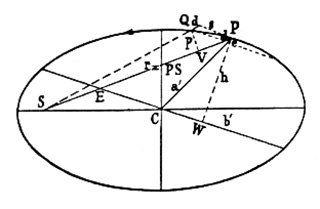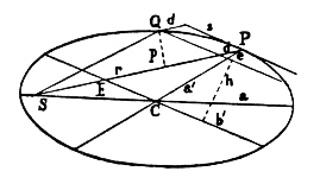In Proposition XI of the Principia, Newton derived, for the case of an elliptical orbit, the centripetal force from Kepler’s laws. In the following diagram the planet is at P while the sun occupies the focus at S.

The small deviation of the planet’s motion from the tangent towards the focus is denoted by e, the motion itself by s. The planetary deviation is proportional to the force and to the square of the time: hence, the force is found by dividing the deviation e by the square of the time interval. Given Kepler’s Area Law, the time interval may be replaced by the area swept out by the radius vector. By taking the time interval and the motion s ever smaller, the area can be given ever more precisely by triangle SPQ. Newton concludes that PE=a, half the major axis.

Dropping a perpendicular p from Q to the radius vector and a perpendicular h from P to b’ (2a’ and 2b’ are conjugate diameters), we have area SPQ= 1/2rP. Because of the similarity of triangles PQV and PEW:
thus for the area we find 1/2 rs (b:b’)
The deviation e is related to the small distance d on the diameter by d:e = a’: a. For the distance e we have, by considering the ellipse as the projection of a circle, the relation
so that e = 1/2 a’/b'[squared] ; d 1/2 as [squared] : b’ [squared]
Then the force is 1/2 as [squared]/ b’ [squared] :
1/4 r [squared] s [squared] b [squared/b’ [squared =
2a/b’ [squared] I/r [squared]
As a result the quantities, depending on the position of the planet in its orbit, have disappeared; for all the points of the ellipse the force is as the inverse square of the distance to the sun.